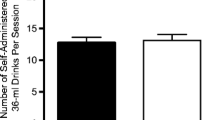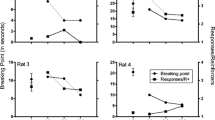Abstract
Each morning eight adults with caffeine versus placebo discrimination histories ingested letter-coded capsules containing 100 mg caffeine or placebo and then engaged in a relaxation or vigilance activity. Subjects were first exposed to caffeine and placebo once each with each activity. Then each day for 10 days subjects made two choices; they chose which compound they would prefer if vigilance were scheduled and which they would prefer if relaxation were scheduled, with the restriction that they could not choose the same compound with both activities; only one choice (randomly selected) was reinforced. Eight of eight subjects always chose caffeine with vigilance. The next choice condition was identical, except that subjects were free to take either compound with both activities. Six of six subjects reliably chose caffeine with vigilance. Four reliably chose placebo with relaxation. In the final condition, each day for 10 days subjects chose between each drug and each of 52 monetary values; those choices were made separately for vigilance and relaxation; only one choice (randomly selected) was reinforced. For six of seven subjects, the maximum dollar value at which subjects chose drug over money was higher for caffeine in vigilance than for placebo in either activity. For five subjects, the maximum value at which subjects chose caffeine over money was higher in vigilance than in relaxation. Overall, this study demonstrates enhanced caffeine reinforcement when a vigilance activity followed drug ingestion.
Similar content being viewed by others
References
Costa PT Jr, McCrae RR (1985) The NEO personality inventory manual. Psychological Assessment Resources, Odessa, Fla
Evans SM, Griffiths RR (1992) Caffeine tolerance and choice in humans. Psychopharmacology 108:51–59
Graham DM (1978) Caffeine — its identity, dietary sources, intake and biological effects. Nutr Rev 36:97–102
Griffiths RR, Mumford GM (1994) Caffeine — a drug of abuse? In: Bloom SE, Kupfer DJ (eds) Psychopharmacology: the fourth generation of progress. Raven, New York (in press)
Griffiths RR, Woodson PP (1988) Reinforcing effects of caffeine in humans. J Pharmacol Exp Ther 246:21–29
Griffiths RR, Bigelow GE, Henningfield JE (1980) Similarities in animal and human drug-taking behavior. In: Mello NK (ed) Advances in substance abuse. JAI Press, Greenwich, pp 1–90
Griffiths RR, Bigelow GE, Liebson IA (1989) Reinforcing effects of caffeine in coffee and capsules. J Exp Anal Behav 52:127–140
Griffiths RR, Troisi JR II, Silverman K, Mumford GK (1993) Multiple-choice procedure: an efficient approach to investigating drug reinforcement in humans. Behav Pharmacol 4:3–13
Haertzen CA (1974) An overview of Addiction Research Center Inventory scales (ARCI): an appendix and manual of scales. US Government Printing Office, Washington, DC, pp 74–92
Hughes JR, Higgins ST, Bickel WK, Hunt WK, Fenwick JW, Gulliver SB, Mireault GC (1991) Caffeine self-administration, withdrawal, and adverse effects among coffee drinkers. Arch Gen Psychiatry 48:611–617
Hughes JR, Hunt WK, Higgins ST, Bickel WK, Fenwick JW, Pepper SL (1992) Effect of dose on the ability of caffeine to serve as a reinforcer in humans. Behav Pharmacol 3:211–218
Huynh H, Feldt LS (1976) Estimation of the Box correction for degrees of freedom from sample data in randomized-block and slit-plot designs. J Educ Statist 1:69–82
Jacob P III, Wilson M, Benowitz NL (1981) Improved gas chromatographic method for the determination of nicotine and cotinine in biologic fluids. J Chromatogr 222:61–70
Johanson CE, Schuster CR (1981) Animal models of drug self-administration. In: Mello NK (ed) Advances in substance abuse: behavioral and biological research. JAI Press, Greenwich, pp 219–297
Oliveto AH, Hughes JR, Higgins ST, Bickel WK, Pepper SL, Shea PJ, Fenwick JW (1992a) Forced-choice versus free-choice procedures: caffeine self-administration in humans. Psychopharmacology 109:85–91
Oliveto AH, Hughes JR, Pepper SL, Bickel WK, Higgins ST (1992b) Low doses of caffeine can serve as reinforcers in humans. In: Harris LS (ed) Problems of drug dependence, 1990. NIDA Research Monograph Series, US Govt Printing Press, Washington, p 442
Pickens R, Meisch RA, Thompson T (1978) Drug self-administration: an analysis of the reinforcing effects of drugs. In: Iversen LL, Iversen SD, Snyder SH (eds) Handbook of psychopharmacology. Plenum, New York, pp 1–37
Silverman K, Griffiths RR (1992) Low-dose caffeine discrimination and self-reported mood effects in normal volunteers. J Exp Anal Behav 57:91–107
Silverman K, Kirby KC, Griffiths RR (1994a) Modulation of drug reinforcement by behavioral requirements following drug ingestion. Psychopharmacology (in press)
Silverman K, Mumford GK, Griffiths RR (1994b) A procedure for studying the within-session onset of human drug discrimination. J Exp Anal Behav (in press)
Spielberger CD, Gorsuch RL, Lushene RE (1970) STAI manual for the state-trait anxiety inventory (“self-evaluation questionnaire”). Consulting Psychologists Press, Palo Alto, Calif.
Stern KN, Chait LD, Johanson CE (1989) Reinforcing and subjective effects of caffeine in normal human volunteers. Psychopharmacology 98:81–88
Young AM, Herling S (1986) Drugs as reinforcers: studies in laboratory animals. In: Goldberg SR, Stolerman IT (eds) Behavior analysis of drug dependence. Academic Press, Orlando, pp 9–67
Author information
Authors and Affiliations
Additional information
Portions of these data were presented at the annual meeting of the American Psychological Association, Boston, August,1991.
Rights and permissions
About this article
Cite this article
Silverman, K., Mumford, G.K. & Griffiths, R.R. Enhancing caffeine reinforcement by behavioral requirements following drug ingestion. Psychopharmacology 114, 424–432 (1994). https://doi.org/10.1007/BF02249332
Received:
Revised:
Issue Date:
DOI: https://doi.org/10.1007/BF02249332




